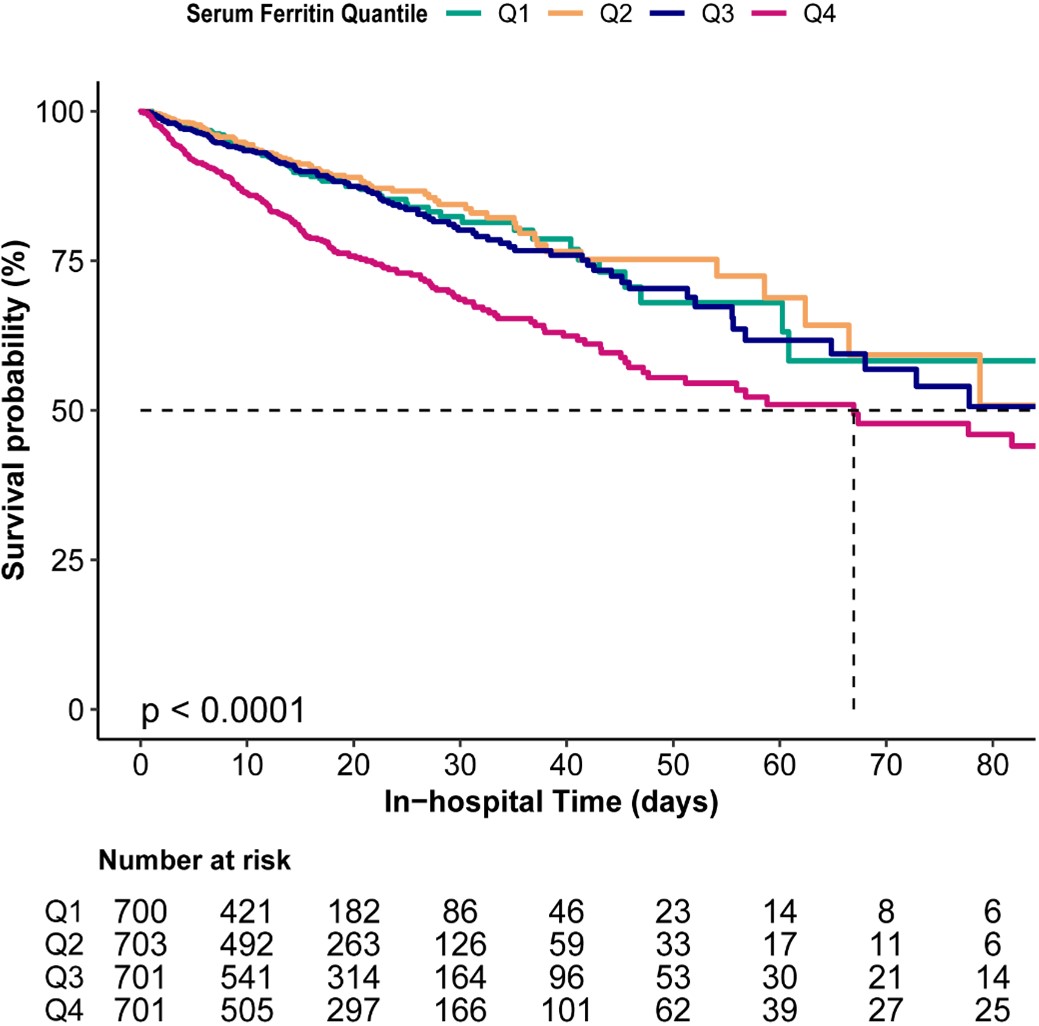Association Between Serum Ferritin and In-hospital Mortality in Critical Ills with Sepsis-Associated Acute Kidney Injury: A Retrospective Cohort Study
Abstract
Background: The association between serum ferritin (SF) and in-hospital mortality in sepsis-associated acute kidney injury (SAAKI) remains unclear. The study explored the relationship between SF and in-hospital mortality in SAAKI patients. Methods: A retrospective cohort study was conducted using data from the Medical Information Mart for Intensive Care-IV2.2 database. The primary outcome was all-cause, in-hospital mortality. Multivariable adjusted Cox regression models were utilized to determine the hazard ratio (HR) and 95% confidence interval (95% CI). The natural logarithm of SF (SF(ln)) was employed for restricted cubic spline regression and threshold effects analyses. Stratified and interaction analyses in different subgroups were performed to assess the relationship's stability.
Results: The study included 2,806 SAAKI patients in the intensive care unit, with a 54.1% male enrollment rate and a mean age of 64.8 ± 16.6 years. After adjusting for potential confounders, SF(ln) was found to be associated with in-hospital mortality among SAAKI patients (HR 1.27; 95% CI, 1.18-1.36; p <0.001). Patients in the highest SF quantile (Q4, SF≥1056.2ng/mL) had an adjusted HR for in-hospital mortality of 1.64 (95% CI, 1.23-2.19; p=0.001). Non-linear associations between SF(ln) and in-hospital mortality were observed, with higher SF levels corresponding to increased mortality risk. Sensitivity analyses across different subgroups yielded consistent results.Conclusion: A nonlinear association was observed between SF and in-hospital mortality among SAAKI patients. Individuals admitted with SF ≥1056.2ng/mL had substantially increased in-hospital mortality. However, additional prospective studies are required to validate these findings.
References
[2] Singer, M., Deutschman, C. S., Seymour, C. W., et al. (2016). The third international consensus definitions for sepsis and septic shock (sepsis-3). JAMA, 315(8), 1–10. https://doi.org/10.1001/jama.2016.0287
[3] Peerapornratana, S., Manrique-Caballero, C. L., Gómez, H., et al. (2019). Acute kidney injury from sepsis: Current concepts, epidemiology, pathophysiology, prevention and treatment. Kidney International, 96(5), 1083–1099. https://doi.org/10.1016/j.kint.2019.05.026
[4] Takasawa, K., Takaeda, C., Wada, T., et al. (2018). Optimal serum ferritin levels for iron deficiency anemia during oral iron therapy (OIT) in Japanese hemodialysis patients with minor inflammation and benefit of intravenous iron therapy for OIT-nonresponders. Nutrients, 10(4), 428. https://doi.org/10.3390/nu10040428
[5] Chen, Q., Gao, M., Yang, H., et al. (2022). Serum ferritin levels are associated with advanced liver fibrosis in treatment-naive autoimmune hepatitis. BMC Gastroenterology, 22(1), 23. https://doi.org/10.1186/s12876-022-02098-z
[6] Lalueza, A., Ayuso, B., Arrieta, E., et al. (2020). Elevation of serum ferritin levels for predicting a poor outcome in hospitalized patients with influenza infection. Clinical Microbiology and Infection, 26(11), 1557.e9–1557.e15. https://doi.org/10.1016/j.cmi.2020.02.018
[7] He, L., Guo, C., Su, Y., et al. (2023). The relationship between serum ferritin level and clinical outcomes in sepsis based on a large public database. Scientific Reports, 13(1), 8677. https://doi.org/10.1038/s41598-023-35874-2
[8] Dimitrijevic, Z. M., Salinger-Martinovic, S. S., Jankovic, R. J., et al. (2019). Elevated serum ferritin levels are predictive of renal function recovery among patients with acute kidney injury. Tohoku Journal of Experimental Medicine, 248(2), 63–71. https://doi.org/10.1620/tjem.248.63
[9] Elm, V. E., Altman, D. G., Egger, M., et al. (2007). Strengthening the reporting of observational studies in epidemiology (STROBE) statement: Guidelines for reporting observational studies. BMJ, 335(7624), 806–808. https://doi.org/10.1136/bmj.39335.541782.AD
[10] Evans, L., Rhodes, A., Alhazzani, W., et al. (2021). Surviving sepsis campaign: International guidelines for management of sepsis and septic shock 2021. Critical Care Medicine, 49(11), e1063–e1143. https://doi.org/10.1097/CCM.0000000000005357
[11] Kellum, J. A., Lameire, N., Aspelin, P., et al. (2012). Kidney disease: Improving global outcomes (KDIGO) acute kidney injury work group. KDIGO clinical practice guideline for acute kidney injury. Kidney International, 2, 1–138.
[12] Zarbock, A., Nadim, M. K., Pickkers, P., et al. (2023). Sepsis-associated acute kidney injury: Consensus report of the 28th Acute Disease Quality Initiative workgroup. Nature Reviews Nephrology, 19(6), 401–417. https://doi.org/10.1038/s41581-023-00683-3
[13] McCullough, K., Bolisetty, S. (2020). Ferritins in kidney disease. Seminars in Nephrology, 40(2), 160–172. https://doi.org/10.1016/j.semnephrol.2020.01.007
[14] Weis, S., Carlos, A. R., Moita, M. R., et al. (2017). Metabolic adaptation establishes disease tolerance to sepsis. Cell, 169(7), 1263–1275.e14. https://doi.org/10.1016/j.cell.2017.05.031
[15] Zarjou, A., Black, L. M., McCullough, K. R., et al. (2019). Ferritin light chain confers protection against sepsis-induced inflammation and organ injury. Frontiers in Immunology, 10, 131. https://doi.org/10.3389/fimmu.2019.00131
[16] He, L., Guo, C., Su, Y., Ding, N. (2023). The relationship between serum ferritin level and clinical outcomes in sepsis based on a large public database. Scientific Reports, 13(1), 8677. https://doi.org/10.1038/s41598-023-35874-2
[17] Shaikh, G. N., Ramamoorthy, J. G., Parameswaran, N., Senthilkumar, G. P. (2022). Serum ferritin for predicting outcome in children with severe sepsis in the pediatric intensive care unit. Indian Pediatrics, 59(12), 939–942. https://doi.org/10.1007/s13312-022-2668-1
[18] Kernan, K. F., Carcillo, J. A. (2017). Hyperferritinemia and inflammation. International Immunology, 29(9), 401–409. https://doi.org/10.1093/intimm/dxx031
[19] Liu, F., Liu, Z. (2023). Association between ferritin to albumin ratio and 28-day mortality in patients with sepsis: A retrospective cohort study. European Journal of Medical Research, 28(1), 414. https://doi.org/10.1186/s40001-023-01405-y
[20] Gunasekaran, C., Eastwood, G. M., Peck, L., et al. (2023). Evaluation of ferritin and the ferritin index as prognostic biomarkers in septic shock. Australian Critical Care, 36(5), 723–731. https://doi.org/10.1016/j.aucc.2022.10.012
[21] He, L., Guo, C., Su, Y., Ding, N. (2023). The relationship between serum ferritin level and clinical outcomes in sepsis based on a large public database. Scientific Reports, 13(1), 8677. https://doi.org/10.1038/s41598-023-35874-2


This work is licensed under a Creative Commons Attribution 4.0 International License.
Copyright for this article is retained by the author(s), with first publication rights granted to the journal.
This is an open-access article distributed under the terms and conditions of the Creative Commons Attribution license (http://creativecommons.org/licenses/by/4.0/).









1.png)














